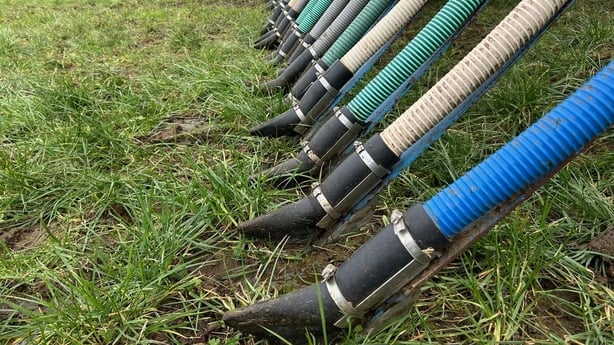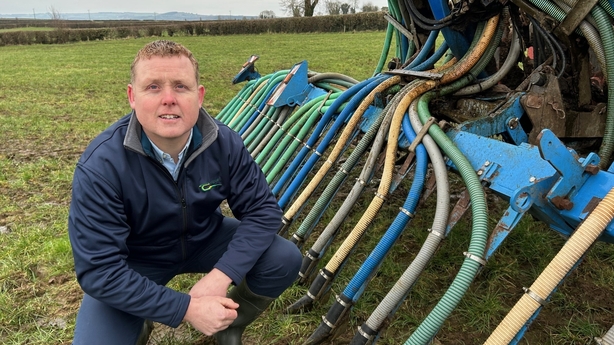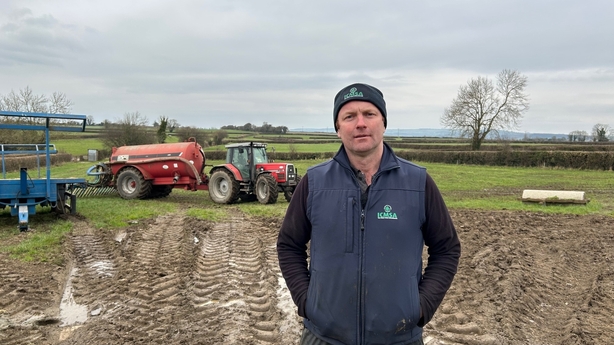Newer more environmentally friendly methods of spreading slurry are having a significant impact on greenhouse emissions, water quality, and the odour previously given off by the process.
From the beginning of this month, farmers across the country have been allowed to begin spreading slurry, but since the start of the year new regulations mean that the number of farms that have to do so in a way that reduces emissions has increased.
Farms stocked at 100 kilograms of nitrogen per hectare or above must use a process called Low Emissions Slurry Spreading (LESS).
The LESS process involves using advanced equipment that applies slurry more precisely and closer to the soil surface compared to the traditional splash-plate method.

It can reduce ammonia emissions from slurry by up to 60%, meaning the strong smell it can have is significantly lessened.
Research Officer with Teagasc Dr David Wall explained that this is because the newer technology means the slurry is spread much closer to the ground with much more of the nutrients going directly into the ground, as opposed to being sprayed off into the atmosphere.
He said that the “slurry is spread in lines, reducing the surface area, which in turn reduces the losses of nitrogen, which means more nutrients for the grass.”
We need your consent to load this comcast-player contentWe use comcast-player to manage extra content that can set cookies on your device and collect data about your activity. Please review their details and accept them to load the content.Manage Preferences
Mr Wall said farmers are embracing the “relatively new technology”, with around 90% of farmers in Ireland adopting LESS.
He adds that they are “beginning to see the positive benefits in terms of being able to replace more of the chemical fertiliser that they would have had to purchase, because it’s more effective and more efficient.
“There are the benefits in terms of the environment as well as the economic benefits,” according to the Teagasc Research Officer.
‘Pros and cons’
ICMSA President and dairy farmer Denis Drennan uses the new LESS process on his farm in Kilkenny.
He said there are “pros and cons” to it.

“There’s more efficient use of the nutrients in the slurry, you can spread on heavier covers of grass as well, so you’re not waiting for the field to be completely bare. But there are cons; you need extra horsepower – I had to change my tractor to go spread slurry – and it’s dangerous enough on hilly and stoney ground,” he said.
The upfront investment for low-emissions slurry spreading equipment can also be quite high.
Mr Drennan said he spent around €70,000, and when he bought his equipment there was no grant system in place, which there is now.
The two most common types of LESS systems used on Irish farms are trailing shoe and dribble bar.
We need your consent to load this comcast-player contentWe use comcast-player to manage extra content that can set cookies on your device and collect data about your activity. Please review their details and accept them to load the content.Manage Preferences
Due to the cost and specialist equipment needed, some farmers are outsourcing slurry spreading on their land to specialist contractors.
The ICMSA says smaller farmers in particular are more likely to do this and it means a contractor can cover multiple farms with the new equipment and the farmer can have slurry spread when they need it done – instead of having to worry about storage, which is another issue.
Planning process like ‘Russian Roulette’
Issues around planning permission for slurry storage are causing problems for farmers, according to the organisation.
Mr Drennan said: “It’s really Russian Roulette applying for planning permission.

“You probably have a 50/50 chance of somebody either objecting who could be living 200 or 300 miles away, or somebody looking for further information – which really delays the process,” he added.
“In fairness to the Government, they’ve announced recently that there’s a 60% grant available for putting up storage facilities, and there was to be a planning exemption that went along with that.
“We’re hearing now the planning exemption may not be available until nearly the end of the year, which is a huge disappointment because there are people ready to go,” he said.
According to the ICMSA President, more slurry storage gives farmers better flexibility.
“The real benefit is that you’re in control of the slurry … so you’re not in a position that the tank is full and has to spread.
“Instead you’re in a position that you know the tank is not going to fill for a number of weeks and you can spread then when it’s more efficient,” said Mr Drennan.
We need your consent to load this rte-player contentWe use rte-player to manage extra content that can set cookies on your device and collect data about your activity. Please review their details and accept them to load the content.Manage Preferences




